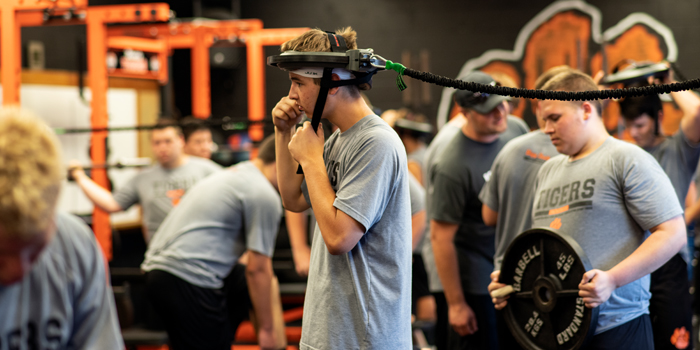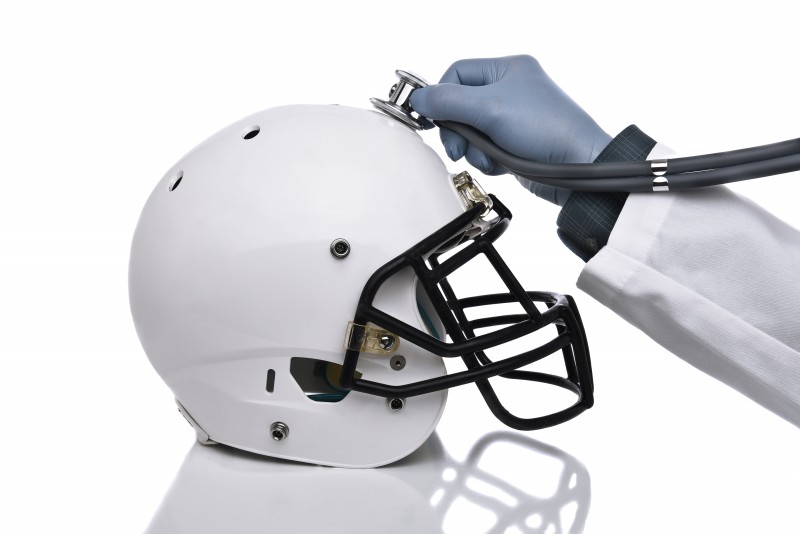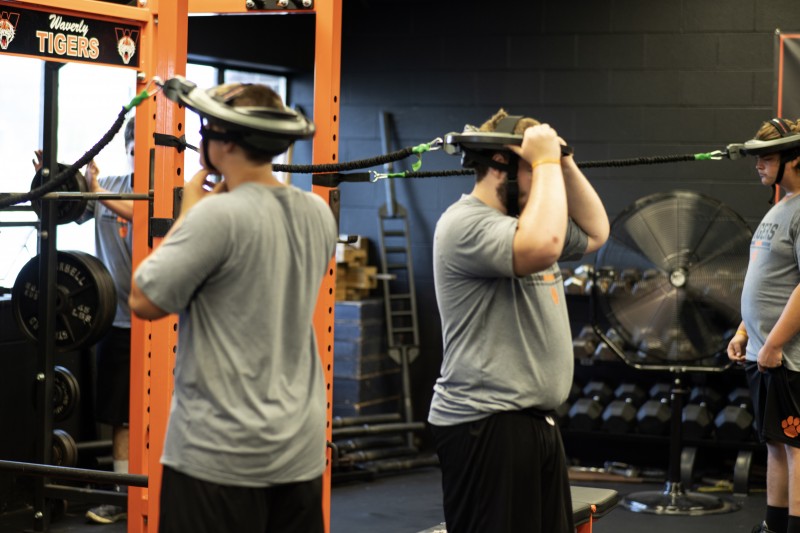
Concussions are a growing epidemic among competitive athletes; even more susceptible are younger athletes at the lower levels of competition. There are a number of concussion experts, including strength and conditioning specialists, neurosurgeons, and other medical researchers, that have theorized stronger neck muscles can help reduce the number and severity of concussions. There is now an ever-growing body of scientific research and anecdotal evidence to back up this theory.
According to the National Federation of State High School Associations, participation in high school athletics has increased for the 22nd straight year. As participation in junior and high school athletics continues to increase, so will the number of sports-related concussions, unless effective concussion prevention programs are developed and implemented.
RELATED: Stronger Necks, Fewer Concussions
The problem is that many times athletes, parents, and/or coaches — those that can benefit the greatest from the implementation of this knowledge — don’t know how to properly apply what the research and evidence support. Therefore, this article also covers some basic neck training guidelines that can be applied immediately.
What is a Concussion?
Most concussions occur when there is an abrupt change in direction of the head. This is likely to occur when an athlete sustains a hit to the body resulting in whiplash or a sudden rotation of the head. A forceful and sudden change in direction can cause the brain to bounce or twist within the skull, which can stretch and damage the brain cells and result in chemical changes within the brain.
Someone doesn’t have to lose consciousness to have sustained a concussion. Some individuals will display the classic symptoms of a concussion, such as blacking out or forgetting what happened immediately before the injury, but other people won’t.
It’s worth noting that after a concussion, the brain is more susceptible to injury. Those who have sustained one concussion are typically more prone to another, especially if a new injury occurs before recovery from the previous concussion is complete.

Steven Cukrov © 123rf.com
What the Research Says
A study published in the Journal of Primary Prevention researchers measured 6,704 male and female high school athletes and found “smaller mean neck circumference, smaller mean neck to head circumference ratio, and weaker mean overall neck strength were significantly associated with concussion.” A strong neck is critical to preventing concussions in male and female athletes participating in sports that involve contact, such as football, wrestling, soccer, and basketball.
The University of Pittsburgh’s Department of Neurological Surgery reports that “The likelihood of suffering a concussion while playing a contact sport is estimated to be as high as 19 percent per year of play. More than 62,000 concussions are sustained each year in high-school contact sports.” The Centers for Disease Control and Prevention cites American football as the most common sport for males in which a concussion is likely to occur and soccer and basketball for female athletes.
In a 2007 study published in the journal Neurosurgery, researchers found that “stronger necks reduced the forces associated with a concussion.” Researchers observed head translational and rotational accelerations, upper neck responses, head kinematics and biomechanics, head displacement, head rotation, and neck loads on 25 impacts to the head using dummies wearing helmets.
The researchers noted that models with stronger necks had a decrease in head velocity as well as head injury criterion when compared to models with weaker necks. Researchers concluded that athletes with weaker necks are more susceptible to concussions because they are not capable of creating the internal muscle forces required to reduce head acceleration caused by a forceful hit (Viano, Casson, and Pellman).
Dr. Robert Cantu, M.D., the co-director of Boston University's Center for the Study of Traumatic Encephalopathy, says, "It's just straight physics. If you see the blow coming and you have a very strong neck and contract the neck muscles, you have a much greater chance to have significantly reduced the forces the brain will see."
Dr. Mickey Collins, M.D., the assistant director of the sports medicine concussion program at the University of Pittsburgh Medical Center, agrees: “We believe one of the best ways to prevent concussions is actually neck strength. Having a strong neck allows the forces of the blow taken from the head to be better transferred down through the neck and into the torso and may certainly help with this issue.”
Dr. Kevin Guskiewicz, Ph.D., the chair of the University of North Carolina's Department of Exercise and Sports Science program says, “We think a lot of it has to do with neck strength. We’re beginning to look at prevention methods that might allow us to strengthen the neck musculature, to try to teach kids how to prepare to take a hit if they get one because we know that to take an ill-prepared hit, where they can’t brace the head and tense the neck muscles, that the forces to the brain are worse than they are if they’re prepared for it.”
READ: Should Kids Play Youth Football?
Mike Gittleson, the strength coach for the University of Michigan for over 30 years, is perhaps one of the most outspoken proponents of neck strengthening to prevent concussions. Gittleson has spoken at conferences and to coaches all over the country about concussions since his retirement in 2008. He also says that many of the 300 plus schools that he has spoken at do not have any kind of neck-strengthening program in place.
Greg Aiello, former head of the NFL’s Head, Neck and Spine Committee, says that while there’s not a league-wide neck-strengthening program, all teams’ strength training programs do include training the neck muscles.
Several strength coaches at the NFL level believe that if neck strength were tested at the NFL combine many coaches at the lower levels would begin instituting a neck-strengthening program.
Ryan Cidzik, the director of football strength and conditioning at the University of Memphis has written that “We saw significantly fewer concussions — 50 percent less — during the 2010 and 2011 seasons. Players who missed playing time due to a head or neck injury also decreased 50 percent over the past two years.”
In September 2010, the University of Eastern Michigan Eagles had 55 “occurrences of neck trauma.” In 2011, the Eagles had only 35 incidences of neck trauma, and the team suffered only three concussions after implementing a neck-strengthening program.

Neck Strengthening Program Development
The neck is capable of performing a very complex number of movements. For the programs that do incorporate neck training, many times their regimen consists only of two sets of ten on a four-way neck. While this is a step in the right direction it’s hardly adequate.
The neck muscles’ primary motions include:
- Flexion (as in tucking the chin to the chest)
- Extension (as in lifting the chin from the chest and tilting the head back)
- Lateral flexion (left and right — as in touching the ear to the shoulder)
- Rotation (left and right — as in looking over the shoulder)
Secondary motions of the neck include:
- Upward diagonal rotation (left and right — as in rotating the chin from the shoulder at an upward 45-degree angle)
- Downward diagonal rotation (left and right — as in rotating the chin downward from a 45-degree angle; the opposite of upward rotation)
Because the neck is capable of moving in so many different directions and angles, a variety of exercises, methods, ranges of motion, and tempos can be used when developing the neck muscles.
Most researchers agree that neck-training machines should be the primary method of strengthening the neck because they offer a quantifiable way to measure and appropriately progress the amount of weight used.
The drawback, however, is that most neck machines work on a single-hinge pattern while the neck is a multi-hinge joint. The alternative method is manual eccentric-based work.
Manual resistance works well because the neck muscles have an ascending strength curve, which means they can exert more force as they become fully contracted. Using manual resistance allows force to be applied in a way that matches the strength curve of the neck muscles, such as applying more resistance when the neck muscles are at their strongest (contracted) and less when they are at their weakest (stretched).
Splitting neck training into different training days makes it easier to devote the time needed to undertake a serious neck-strengthening program. For example, pairing flexion and extension exercises together on one day and lateral flexion and rotational exercises together on another day.
Some collegiate strength coaches have their athletes spend the first 20 to 25 minutes of their workouts training the neck. This ensures neck training is being treated as a priority and is done when the athletes are fresh. It also builds in accountability because the major compound lifts cannot be performed until all sets and reps have been completed for the neck.
Loading Parameters for Neck Strengthening
Reps and Sets
The muscles of the neck are generally comprised of slow-twitch muscle fibers. This means that they’re not very strong but are fairly resistant to fatigue. Therefore the rep range for most athletes would be in the eight to twenty range.
MORE: The Art of Programming for Injury Prevention/Risk Management
Since the neck muscles are typically untrained in most athletes, significant results can be obtained even using a minimal number of sets. For most athletes, three sets for each of the primary neck functions are recommended to expedite progress.
Even one set of 15 to 20 reps is optimal when neck training is first introduced into an athlete’s program.
Tempo and Rest Intervals
Since the range of motion in neck exercises is relatively short, tempos with shorter eccentric/concentric speeds work well. For example, a tempo of 2-0-1-0 where it takes two seconds during the eccentric (lowering/stretching) and one second for the concentric (raising/contracting). However, in grappling sports, where isometric tension is required, tempos with longer isometric holds may be better — for example, a tempo of 1-0-1-8 (an eight-second isometric hold against resistance in the contracted position).
The neck muscles are relatively small and have a large vascular supply, which means they recover quickly between sets. For most athletes rest intervals of 10 to 75 seconds between sets works well.
As participation in junior and high school athletics continues to increase, unfortunately, so will the number of sports-related injuries. Many concussions at lower levels of competition may be avoidable if proper prevention programs are adopted as part of sports performance and strength and conditioning programs.
The research and evidence are becoming increasingly clear: stronger necks can help prevent concussions. So, what are you waiting for? Get ahead of the game, strengthen your neck, and protect your head.
References
- Viano DC, Casson IR, Pellman EJ. Concussion in professional football: biomechanics of the struck player--part 14. Neurosurgery. 2007 Aug;61(2):313-27; discussion 327-8. PubMed PMID: 17762744.
- Collins CL, Fletcher EN, Fields SK, Kluchurosky L, Rohrkemper MK, Comstock RD, Cantu RC. Neck strength: a protective factor reducing risk for concussion in high school sports.J Prim Prev. 2014 Oct;35(5):309-19. doi: 10.1007/s10935-014-0355-2. PubMed PMID: 24930131.
- http://www.rwjf.org/en/blogs/new-public-health/2012/02/faces-of-public-health-kevin-guskiewicz-md.html (accessed October 1, 2012)
- http://www.training-conditioning.com/2012/05/28/strong_necks/index.php (accessed October 1, 2012)
- http://sportsillustrated.cnn.com/2012/football/ncaa/09/28/concussions-neck-strength-syracuse-eastern-michigan/ (accessed October 1, 2012)
- http://www.cdc.gov/headsup/basics/concussion_whatis.html (accessed June 26, 2016)
Chris Dellasega has a master’s degree in exercise science and has been studying human performance for over 20 years. He is the founder of the Athletic Strength Institute, a sports performance training facility in Lawrence, Kansas. He currently serves as a strength coach for USA Cycling’s Men’s Track program, trains athletes from the Women’s Endurance Track program, and track cycling sprinters. Chris trains a three-time World Record holder, multiple national champions, and has worked with professional athletes from the NFL, PGA, and MLB as well as a number of collegiate (Divisions I and II), amateur, and high school athletes. Prior to opening the Athletic Strength Institute, Chris was a coach and assistant course instructor for the Poliquin Group, served as the high performance director for a biomechanics research company, and the director of exercise science for a private training facility.











1 Comment